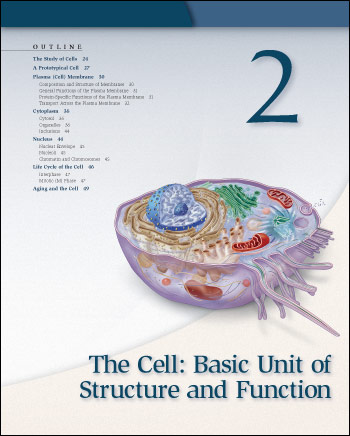
This is a huge resource from text book manufacturer McGrawHill.
Active Art Library![]() Active Art Demo (792.0K)
Active Art Demo (792.0K)
Active Art consists of art files that have been converted to a format that allows the artwork to be edited inside of PowerPoint. Each piece can be broken down to its core elements, grouped or ungrouped, and edited to create customized illustrations.
Chapter 5
-Lysosomes
Chapter 6
- Sodium-Potassium Exchange Pump
- Cotransport
- Endocytosis and Exocytosis
- Proton Pump
Chapter 7
- How Intracellular Receptors Regulate Gene Transcription
- Second Messengers - The cAMP and Ca Pathways
- Signal Amplification
Chapter 8
- A Biochemical Pathway
- Feedback Inhibition of Biochemical Pathways
Chapter 9
- Electron Transport System and ATP Synthesis
Chapter 10
- Cyclic and Noncyclic Photophosphorylation
- Photosynthetic Electron Transport and ATP Synthesis
Chapter 11
- Mitosis and Cytokinesis
- Cell Proliferation Signaling Pathway
- Bidirectional Replication of DNA
- Unique Features of Meiosis
Chapter 12
- Comparison of Meiosis and Mitosis
- Random Orientation of Chromosomes During Meiosis
- Stages of Meiosis
Chapter 14
- Hershey and Chase Experiment
- Meselson and Stahl Experiment
- DNA Replication Fork
- How Nucleotides are Added in DNA Replication
Chapter 15
- Processing of Gene Information - Prokaryotes versus Eukaryotes
- Protein Synthesis
- How Spliceosomes Process RNA
Chapter 16
- Restriction Endonucleases
- Restriction Fragment Length Polymorphisms
- Early Genetic Engineering Experiment
- Constructing Vaccines
- Southern Blot
- cDNA
- Steps in Cloning a Gene
- Polymerase Chain Reaction
- Microarray
- The Ti Plasmid
Chapter 18
- The Tryptophan Repressor
- Combination of Switches - the Lac Operon
- Control of Gene Expression in Eukaryotes
- Transcription Complex and Enhancers
Chapter 20
- Integration and Excision of a Plasmid
- Mechanism of Transposition
- The Consequence of Inversion
- Control of the Cell Cycle
- Slipped-strand Mispairing
- Conjugation with F Plasmid
- Thymine Dimers
- How Tumor Suppressor Genes Block Cell Division
Chapter 21
- The Consequence of Inversion
Chapter 26
- Treatment of HIV
- How Prions Arise
- HIV Replication
Chapter 28
- Malaria - Life Cycle of Plasmodium
Chapter 42
- Sarcomere Shortening
Chapter 43
- Three Phases of Gastric Secretion
Chapter 44
- Changes in the Partial Pressures of Oxygen and Carbon Dioxide
Chapter 45
- Chemical Synapse
- Membrane-Bound Receptors G Proteins and Ca2 Channels
- Voltage Gated Channels and the Action Potential
- Sodium-Potassium Exchange
- Action Potential Propagation in an Unmyelinated Axon
- Function of the Neuromuscular Junction
Chapter 46
- Effect of Sound Waves on Cochlear Structures
Chapter 47
- Mechanism of Steroid Hormone Action
- Mechanism of Thyroxine Action
- Action of Epinephrine on a Liver Cell
Chapter 48
- Cytotoxic T-cell Activity Against Target Cells
- Interaction of Antigen Presenting Cells and T-helper Cells
- Monoclonal Antibody Production
- IgE Mediated Hypersensitivity
Chapter 50
- Spermatogenesis
Chemistry
# Chapter Quiz: Test yourself over the chapter content. Hints and instructive feedback are provided to help you determine why wrong answers are incorrect.
# Outlines: Get a detailed outline of the chapter to help you study.
# Flashcards: Practice with flashcards to make sure you know the key terms from each chapter.
MORE McGRAW Animations... from "Human Anatomy"

The Cell: Basic Unit of Structure and Function
Animation: Comparison of Meiosis and Mitosis (Quiz 1)
Animation: Comparison of Meiosis and Mitosis (Quiz 2)
Animation: Control of the Cell Cycle
Animation: How Diffusion Works
Animation: How Enzymes Work
Animation: How Facilitated Diffusion Works
Animation: How Osmosis Works
Animation: How the Cell Cycle Works
Animation: How the Sodium Potassium Pump Works
Animation: Lysosomes
Animation: Mitosis and Cytokinesis
Animation: Phagocytosis
Animation: Receptors Linked to a Channel Protein
Challenge Yourself
Difficult Multiple Choice
Simple Multiple Choice
Answers to Content Review
Answers to What Did You Learn?
Crossword Puzzle
Flashcards
Labeling Exercises
Links Library
Embryology
Animation: Comparison of Meiosis and Mitosis (Quiz 1)
Animation: Comparison of Meiosis and Mitosis (Quiz 2)
Animation: Fetal Development and Risk
Animation: How Meiosis Works
Animation: Random Orientation of Chromosomes During Meiosis
Animation: Sodium-Potassium Exchange Pump (Quiz 1)
Animation: Sodium-Potassium Exchange Pump (Quiz 2)
Animation: Sodium-Potassium Exchange Pump (Quiz 3)
Animation: Stages of Meiosis
Animation: Unique Features of Meiosis
Muscle Tissue and Organization
Animation: Action Potentials and Muscle Contraction
Animation: Breakdown of ATP and Cross-Bridge Movement During Muscle Contraction
Animation: Function of the Neuromuscular Junction (Quiz 1)
Animation: Function of the Neuromuscular Junction (Quiz 2)
Animation: Function of the Neuromuscular Junction (Quiz 3)
Animation: Myofilament Contraction
Animation: Sarcomere Contraction
Nervous Tissue
Animation: Chemical Synapse (Quiz 1)
Animation: Chemical Synapse (Quiz 2)
Animation: The Nerve Impulse
Animation: Transmission Across a Synapse
Senses
Animation: Effect of Sound Waves on Cochlear Structures (Quiz 1)
Animation: Effect of Sound Waves on Cochlear Structures (Quiz 2)
Endocrine System
Animation: Blood Sugar Regulation in Diabetics
Animation: Hormonal Communication
Animation: Positive and Negative Feedback (Quiz 1)
Animation: Positive and Negative Feedback (Quiz 2)
Blood
Animation: Cytotoxic (Type II Hypersensitivity)
Animation: Hemoglobin Breakdown
Animation: Hemolysis and Crenation
Lymphatic System
Animation: Cytotoxic T-Cell Activity against Target Cells (Quiz 1)
Animation: Cytotoxic T-Cell Activity Against Target Cells (Quiz 2)
Animation: HIV Replication
Animation: How the HIV Infection Cycle Works
Animation: The Immune Response
Reproductive System
Animation: Comparison of Meiosis and Mitosis (Quiz 1)
Animation: Comparison of Meiosis and Mitosis (Quiz 2)
Animation: How Meiosis Works
Animation: Maturation of the Follicle and Oocyte
Animation: Positive and Negative Feedback (Quiz 1)
Animation: Positive and Negative Feedback (Quiz 2)
Animation: Random Orientation of Chromosomes During Meiosis
Animation: Spermatogenesis (Quiz 1)
Animation: Spermatogenesis (Quiz 2)
Animation: Stages of Meiosis
Animation: Unique Features of Meiosis
No comments:
Post a Comment